
Did you know the telegraph revolutionized long-distance communication? It's a piece of history that transformed the world, making it smaller and more connected. Before the internet or even the telephone, the telegraph was sending messages across continents in mere minutes. This fascinating invention has a rich history, full of intriguing facts that many might not know. From its impact on the Civil War to its role in the creation of time zones, the telegraph's influence is vast and varied. In this post, we'll uncover 12 captivating facts about the telegraph, shedding light on how this remarkable technology shaped communication and the modern world. So, if you're curious to learn more about this groundbreaking invention, keep reading!
The Telegraph's Origins
The telegraph revolutionized communication in the 19th century. Before its invention, messages took days or weeks to travel. Let's dive into some fascinating facts about this groundbreaking technology.
-
Samuel Morse, an American inventor, developed the first practical telegraph system in the 1830s. His invention included the famous Morse code, a system of dots and dashes representing letters and numbers.
-
The first successful telegraph message was sent on May 24, 1844, from Washington, D.C., to Baltimore. The message read, "What hath God wrought?" and marked the beginning of a new era in communication.
How the Telegraph Works
Understanding how the telegraph operates helps appreciate its impact. It uses electrical signals to transmit messages over long distances.
-
Telegraph systems use a series of electrical pulses to represent characters. These pulses travel through wires, allowing messages to be sent quickly over vast distances.
-
Operators at each end of the telegraph line use a device called a telegraph key to send and receive messages. The key opens and closes an electrical circuit, creating the pulses that form the message.
The Telegraph's Impact on Society
The telegraph had a profound effect on society, changing the way people communicated and conducted business.
-
The telegraph greatly improved the speed of news dissemination. Newspapers could receive updates from distant locations in hours instead of days, leading to more timely reporting.
-
Businesses benefited from the telegraph by being able to communicate quickly with suppliers and customers. This efficiency helped spur economic growth and development.
The Telegraph in War
The telegraph played a crucial role in military operations, providing a strategic advantage to those who used it effectively.
-
During the American Civil War, both the Union and Confederate armies used the telegraph for communication. It allowed commanders to send orders and receive intelligence rapidly, influencing the outcome of battles.
-
The Crimean War (1853-1856) saw the first extensive use of the telegraph in a European conflict. It enabled faster communication between the front lines and government officials, changing the nature of warfare.
The Decline of the Telegraph
Despite its revolutionary impact, the telegraph eventually became obsolete with the advent of newer technologies.
-
The invention of the telephone by Alexander Graham Bell in 1876 marked the beginning of the end for the telegraph. The telephone allowed for real-time voice communication, which was more efficient and user-friendly.
-
By the mid-20th century, the rise of radio and television further diminished the telegraph's importance. These new technologies provided faster and more versatile means of communication.
The Telegraph's Legacy
Even though the telegraph is no longer widely used, its legacy lives on in modern communication technologies.
-
The principles of telegraphy laid the groundwork for the development of the internet. The idea of sending information through electrical signals is fundamental to both technologies.
-
Morse code, developed for the telegraph, is still used today in various fields, including aviation and amateur radio. It remains a vital tool for communication in situations where voice transmission is impractical.
A Final Morse Code Message
We've journeyed through the fascinating world of telegraphs, uncovering bits of history, technology, and impact that have shaped communication as we know it. From the early days of electrical signals to the Morse code that bridged continents, the telegraph's legacy is undeniable. It revolutionized the way news was shared, businesses operated, and people connected. Even though newer technologies have taken the spotlight, the spirit of innovation and instant connection that the telegraph introduced lives on. Remember, every text message or email sent today owes a nod to the pioneering technology of the telegraph. It's a testament to human ingenuity and the relentless pursuit of progress. So, next time you hit send, think of it as your own Morse code message, echoing through the digital age.
Was this page helpful?
Our commitment to delivering trustworthy and engaging content is at the heart of what we do. Each fact on our site is contributed by real users like you, bringing a wealth of diverse insights and information. To ensure the highest standards of accuracy and reliability, our dedicated editors meticulously review each submission. This process guarantees that the facts we share are not only fascinating but also credible. Trust in our commitment to quality and authenticity as you explore and learn with us.


